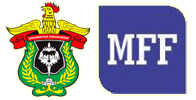PRODUKSI NANOPARTIKEL PERAK MENGGUNAKAN INFUSA RIMPANG LAKKA - LAKKA (Curculigo orchioides Gaertn.) SEBAGAI BIO-REDUCTOR VARIASI KONSENTRASI AGNO3 DAN WAKTU REDUKSI
Keywords:
nanopartikel perak, bioreduktor, lakka-lakka (Curculigo orchioides Gaertn.)Abstract
Nanopartikel perak dapat disintesis dengan metode fisika dan kimia. Namun karena toksik dan tidak ramah lingkungan, pemanfaatan tanaman sebagai bioreduktor menjadi pilihan utama. Pada penelitian ini, sari infusa rimpang lakka-lakka digunakan sebagai bioreduktor pada biosintesis nanopartikel perak. Nanopartikel perak telah diproduksi dengan variasi konsentrasi AgNO3 1, 3, dan 5 mM dan waktu reduksi 0, 15, 45, 60, dan 90 menit untuk mengevaluasi kondisi optimum pada produksi nanopartikel perak. Berdasarkan hasil yang teridentifikasi dari spekatra UV-Vis, nanopartikel perak dapat diproduksi pada semua kondisi reaksi. Namun pada konsentrasi 5 mM dan waktu reduksi 45 menit, nukleasi nanopartikel perak lebih awal terbentuk dibandikan dengan yang lain.
References
Gajbhiye S, Sakharwade S. Silver Nanoparticles in Cosmetics. Journal of Cosmetics, Dermatological Sciences and Applications. 2006; 06(01):48-53. DOI: 10.4236/jcdsa.2016.61007
Handayani W. Pemanfaatan Tumbuhan Tropis untuk Biosintesis Nanopartikel Perak dan Aplikasinya sebagai Indikator Kolorimetri Keberadaan Logam Berat, Tesis, M.Si., Indonesia University, Jakarta. 2011.
Bakir. Pengembangan Biosintesis Nanopartikel Perak Menggunakan Air Rebusan daun Bisbul (Diospyros blancoi) untuk Deteksi Ion Tembaga (II) dengan Metode Kolorimetri’, Skripsi, S.Si., Indonesia University, Jakarta. 2011
Payapo IA, Zakir M, Soekamto NH. Sintesis Nanopartikel Perak Menggunakan Bioreduktor Ekstrak Daun Ketapang (Terminalia catappa) dan Potensinya Sebagai Tabir Surya, Jurusan Kimia FMIPA Universitas Hasanuddin, Makassar. 2005
Thakkar KN, Mhatre S, Parikh RY. Biological Synthesis of Metallic Nanoparticles. Nanomedicine: Nanotechnology, Biology, and Medicine. 2009; 6(2):257-262. DOI: 10.1016/j.nano.2009.07.002
Shankar SS, Rai A, Ahmad A, Sastry M. Rapid synthesis of Au, Ag, and bimetallic Au core–Ag shell nanoparticles using Neem (Azadirachta indica) leaf broth. Jurnal of Colloid and Interface Scince. 2004; 275(2):496-502. DOI: 10.1016/j/jcis.2004.03.003
Lembang EY. Sintesis Nanopartikel Perak dengan Metode Reduksi Menggunakan Bioreduktor Ekstrak Daun Ketapang (Terminalia catappa), Skripsi, S.Si., Hasanuddin University, Makassar. 2013
Elumalai EK, Prasad TNVKV, Nagajyothi PC, David E. A Bird’s Eye View on Biogenic Silver Nanoparticles and Their Applications. Der Chemica Sinica. 2011; 2(2): 88-97.
Soni N, Lal VK, Agrawal S, Verma H. Golden Eye Grass – Magical Remedy By Nature. International Journal of Pharmaceutical Scinces and Research. 2012; (8) : 2407-2420. DOI: 10.13040/IJPSR.0975-8232
Tang SY, Whiteman M, Peng ZF, Jenner A, Yong EL, Halliwell B. Characterization of antioxidant and antiglycation propertiesand isolation of active ingredients from traditional Chinesemedicines. Free Radic Biol Med. 2004; 36(12):1575–1587. DOI: 10.1016/j.freeradbiomed.2004.03.017
Song JY, Kim BS. Rapid Biologycal Synthesis of Silver Nanoparticles Using Plant Leaf Extracts. Bioprocess Biosyst Engineering. 2008; 32(1) : 79-84. DOI: 10.1007/s00449-008-0024-6
Masakke Y, Sulfikar, Rasyid M. Biosintesis Partikel-nano Perak Menggunakan Ekstrak Metanol Daun Manggis (Garcinia mangostana L.). Jurnal Sainsmat. 2015; Vol.IV, No.1: 28-41. ISSN 2086-6755
Handayani H, Bakir, Imawan C, Purbaningsih S. Potensi Ekstrak Beberapa Jenis Tumbuhan Sebagai Agen Pereduksi Untuk Biosintesis Nanopartikel Perak Biosintesis Nanopartikel Perak, Seminar Nasional Biologi, Gadjah Mada University, Yogyakarta, 2010; 558-567.
Philip D. Green Shyntesis of Gold & Silver Nanoparticles Using Hibiscus rosa sinensis. Physica E Low-dimensional System and Nanostructure. 2010; 42(5) : 1417-1424. DOI : 10.1016/j/physe.3009.11.081
Jain D, Daima HK, Kachhwala, Kothari SL. Synthesis of Plant Mediated Silver Nanoparticles Usng Papaya Fruit Extract and Evaluation of Their Anti Microbial Activities, Digest Journal of Nanomaterials and Biostructures. 2009; 4(3): 557-563.
Kumar V, Yadav SC, Yadaf SK. Syzygium cumini leaf and Seed Extract Mediated Biosythesis of Silver Nanoparticles and Their Characterization. Journal Chemistry Technology and Biotechnology. 2010; 85(10): 1-9. DOI: 10.1002/jctb.2427
Nalawati AN. Sintesis Nanopartikel Perak (NPAg) Dengan Metode Yang Ramah Lingkungan Dan Kajian Aktifitasnya Dalam Menghambat Pertumbuhan Bakteri Gram Positif Dan Bakteri Gram Negatif . Tesis, M.Si., Bogor Agricultural University, Bogor. 2015
Singh R, Wagh P, Wadhwani S, Gaidhani S, Kumbhar A, Bellare J, Chopade BA. Synthesis, Optimization, and Characterization of Silver Nanoparticles from Acinetobacter calcoaceticus and Their Enhanced Antibacterial Activity When Combined with Antibiotics.Int J Nanomedicine. 2013; 8: 4277-4290. DOI: 10.2147/IJN.S48913

Downloads
Published
Issue
Section
License
Copyright (c) 2020 Majalah Farmasi dan Farmakologi

This work is licensed under a Creative Commons Attribution-NonCommercial 4.0 International License.
The copyright to this article is transferred to Universitas Hasanuddin (UNHAS) if and when the article is accepted for publication. The undersigned hereby transfers all rights in and to the paper including without limitation all copyrights to UNHAS. The undersigned hereby represents and warrants that the paper is original and that he/she is the author of the paper, except for material that is clearly identified as to its original source, with permission notices from the copyright owners where required. The undersigned represents that he/she has the power and authority to make and execute this assignment.
We declare that:
- This paper has not been published in the same form elsewhere.
- It will not be submitted anywhere else for publication prior to acceptance/rejection by this Journal.
- A copyright permission is obtained for materials published elsewhere and which require this permission for reproduction.
Furthermore, I/We hereby transfer the unlimited rights of publication of the above-mentioned paper in whole to UNHAS The copyright transfer covers the exclusive right to reproduce and distribute the article, including reprints, translations, photographic reproductions, microform, electronic form (offline, online) or any other reproductions of similar nature.
The corresponding author signs for and accepts responsibility for releasing this material on behalf of any and all co-authors. This agreement is to be signed by at least one of the authors who have obtained the assent of the co-author(s) where applicable. After submission of this agreement signed by the corresponding author, changes of authorship or in the order of the authors listed will not be accepted.

